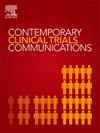左腹内侧前额叶皮层抑制rTMS作为阿片类药物使用障碍的抗应激干预:试验设计。
IF 1.4
Q4 MEDICINE, RESEARCH & EXPERIMENTAL
引用次数: 0
摘要
背景:在物质使用障碍(sud)患者中,压力暴露可损害执行功能,增加对药物使用的渴望和复发的可能性。研究表明,急性压力源会增加寻求药物的行为;然而,这种效应背后的机制尚不完全清楚。竞争神经行为决策系统理论认为,患有sud的人可能有过度活跃的边缘奖励回路和不活跃的执行控制回路。目的:探讨针对左侧腹内侧前额叶皮质(vmPFC)的抑制性重复经颅磁刺激(rTMS)如何改变阿片类药物使用障碍患者应激性执行功能障碍、情绪失调和药物寻求。方法:我们将研究心理应激源联合抑制性(1Hz)左vmPFC rTMS对接受阿片类激动剂治疗的参与者(N = 24)的影响。参与者接受自传体应激源的引导图像,与10次主动vmPFC rTMS和假rTMS配对(受试者内随机交叉)。压力诱发的功能障碍将与rtms前后的认知(如执行功能)、情感(如情绪唤醒)和行为(如寻求阿片类药物)测量指标相关联。为了确认这些变化与目标区域的神经活动改变有关,我们将使用EEG测量关键任务期间的事件相关电位。我们假设压力源会增加执行功能障碍、情绪失调和药物寻求,而左vmPFC抑制rTMS会减少边缘激活,这可能转化为减少渴望和药物寻求。结论:我们的发现应该为神经网络如何调节sud患者的药物寻求和相关功能障碍提供见解。这项研究和类似研究的结果可以促进理论和对sud患者的神经调节干预。本文章由计算机程序翻译,如有差异,请以英文原文为准。
Left ventromedial prefrontal cortex inhibitory rTMS as an anti-stress intervention in opioid use disorder: Trial design
Background
In people with substance use disorders (SUDs), stress-exposure can impair executive function, and increase craving and likelihood of drug-use recurrence. Research shows that acute stressors increase drug-seeking behavior; however, mechanisms underlying this effect are incompletely understood. The Competing Neurobehavioral Decisions System theory posits that persons with SUDs may have hyperactive limbic reward circuitry and hypoactive executive control circuitry.
Objective
To investigate how inhibitory repetitive transcranial magnetic stimulation (rTMS) targeting the left ventromedial prefrontal cortex (vmPFC) may alter stress-induced executive dysfunction, emotion dysregulation, and drug-seeking in people with opioid use disorder.
Methods
We will examine effects of a psychological stressor combined with inhibitory (1Hz) left vmPFC rTMS in participants (N = 24) receiving opioid agonist treatment. Participants undergo guided imagery of autobiographical stressors paired with 10 sessions of active vmPFC rTMS vs. sham (within-subject randomized crossover). Stress-induced dysfunction will be indexed with cognitive (e.g., executive function), affective (e.g., emotional arousal), and behavioral (e.g., opioid-seeking) measures pre- and post-rTMS. To confirm changes are associated with altered neural activity in targeted regions, we will measure event-related potentials during key tasks using EEG. We hypothesize that stressors will increase executive dysfunction, emotion dysregulation, and drug-seeking, and that left vmPFC inhibitory rTMS will decrease limbic activation, which could translate to reduced craving and drug-seeking.
Conclusion
Our findings should offer insights into how neural networks modulate drug-seeking and associated dysfunctions in people with SUDs. The results of this and similar studies can advance theory and neuromodulation interventions for people with SUDs.
求助全文
通过发布文献求助,成功后即可免费获取论文全文。
去求助
来源期刊

Contemporary Clinical Trials Communications
Pharmacology, Toxicology and Pharmaceutics-Pharmacology
CiteScore
2.70
自引率
6.70%
发文量
146
审稿时长
20 weeks
期刊介绍:
Contemporary Clinical Trials Communications is an international peer reviewed open access journal that publishes articles pertaining to all aspects of clinical trials, including, but not limited to, design, conduct, analysis, regulation and ethics. Manuscripts submitted should appeal to a readership drawn from a wide range of disciplines including medicine, life science, pharmaceutical science, biostatistics, epidemiology, computer science, management science, behavioral science, and bioethics. Contemporary Clinical Trials Communications is unique in that it is outside the confines of disease specifications, and it strives to increase the transparency of medical research and reduce publication bias by publishing scientifically valid original research findings irrespective of their perceived importance, significance or impact. Both randomized and non-randomized trials are within the scope of the Journal. Some common topics include trial design rationale and methods, operational methodologies and challenges, and positive and negative trial results. In addition to original research, the Journal also welcomes other types of communications including, but are not limited to, methodology reviews, perspectives and discussions. Through timely dissemination of advances in clinical trials, the goal of Contemporary Clinical Trials Communications is to serve as a platform to enhance the communication and collaboration within the global clinical trials community that ultimately advances this field of research for the benefit of patients.
 求助内容:
求助内容: 应助结果提醒方式:
应助结果提醒方式:


